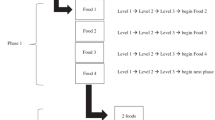Abstract
This study evaluates the effectiveness of a variation of the high-probability (high-p) sequence involving bites of food as high-p tasks on the acceptance of low-probability (low-p) foods in an adolescent with autism spectrum disorder. After demonstrating the effectiveness of the high-p sequence using a reversal design, the participant’s mother implemented the intervention. Intervention effects were partially maintained during 7-month maintenance probes. Implications for research and practice are provided.

Similar content being viewed by others
Notes
Inappropriate mealtime behavior was only measured with two of the participants.
References
Bachmeyer, M. H. (2009). Treatment of selective and inadequate food intake in children: a review and practical guide. Behavior Analysis in Practice, 2, 43–50.
Dawson, J. E., Piazza, C. C., Sevin, B. M., Gulotta, C. S., Lerman, D., & Kelly, M. L. (2003). Use of the high-probability instructional sequence and escape extinction in a child with food refusal. Journal of Applied Behavior Analysis, 36, 105–108. doi:10.1901/jaba.2003.36-105.
Meier, A. E., Fryling, M. J., & Wallace, M. D. (2012). Using high-probability foods to increase the acceptance of low-probability foods. Journal of Applied Behavior Analysis, 45, 149–153. doi:10.1901/jaba.45-149.
Patel, M. R., Reed, G. K., Piazza, C. C., Muller, M., Bachmeyer, M. H., Layer, S. A., & Pabico, R. S. (2006). An evaluation of a high-probability instructional sequence to increase acceptance of food and decrease inappropriate behavior in children with pediatric feeding disorders. Research in Developmental Disabilities, 27, 430–442. doi:10.1016/j.ridd.2005.05.005.
Patel, M. R., Reed, G. K., Piazza, C. C., Muller, M., Bachmeyer, M. H., & Layer, S. A. (2007). Use of a high-probability instructional sequence to increase compliance to feeding demands in the absence of escape extinction. Behavioral Interventions, 22, 305–310. doi:10.1002/bin.251.
Seubert, C., Fryling, M. J., Wallace, M. D., Jiminez, A., & Meier, A. (2014). Antecedent interventions for pediatric feeding problems. Journal of Applied Behavior Analysis, 47, 449–457. doi:10.1002/jaba.11.
Author information
Authors and Affiliations
Corresponding author
Additional information
-Intervention may be considered preventative and used with less severe feeding problems
-Parents may implement this intervention with integrity
-Critical to consider the child’s chewing and swallowing skills before implementing
-Systematic fading may be necessary
Rights and permissions
About this article
Cite this article
Ewry, D.M., Fryling, M.J. Evaluating the High-Probability Instructional Sequence to Increase the Acceptance of Foods with an Adolescent with Autism. Behav Analysis Practice 9, 380–383 (2016). https://doi.org/10.1007/s40617-015-0098-4
Published:
Issue Date:
DOI: https://doi.org/10.1007/s40617-015-0098-4




